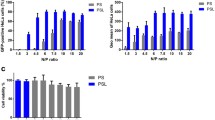Abstract
Purpose. One of the drawbacks of polycationic and cationic liposomalgene transfer is its sensitivity to serum. Gene therapy requires thetransfectant-DNA complex to be resistant to serum as well as blood.Since Ca2+ has proved to be an efficient cofactor of polycationic genetransfer, we decided to investigate its effects on transfection in thepresence of serum.
Methods. We studied transgene expression of luciferase gene (pCMVLuc) on ECV 304 human endothelial cells using H1 histone andDOSPER as transfectants in the presence of 0-100% fetal calf serum.
Results. H1-and DOSPER-mediated transfection was found to beinhibited by serum above the concentration of 10%. If 2 mM Ca2+ or2 mM Ca2+/0.1 mM chloroquine was included in the culture mediumwhich replace the transfection mixture and was left on the cells for24 hours postincubation, the inhibiting effect of even 100% serumwas overcome.
Conclusions. A high serum level does not interfere with binding anduptake of H1- and DOSPER-DNA complexes, but inhibits subsequentsteps such as endosomal escape. Ca2+ in the form of nascent calciumphosphate microprecipitates and other lysosomolytical agents facilitateendosomal/lysosomal release by their fusigenic and membranolyticactivity.
Similar content being viewed by others
REFERENCES
F. D. Ledley. Nonviral gene therapy: the promise of genes as pharmaceutical products. Hum. Gene Ther. 6:1129-1144 (1995).
E. R. Lee, J. Marshall, C. S. Siegel, C. Jiang, N. S. Yew, M. R. Nichols, J. P. Nietupski, R. J. Ziegler, M. B. Lane, K. X. Wang, N. C. Wan, R. K. Scheule, D. J. Harris, A. E. Smith, and S. H. Cheng. Detailed analysis of structure and formulations of cationic lipids for efficient gene transfer to the lung. Hum. Gene Ther. 7:1701-1717 (1996).
Y. Saeki, N. Matsumoto, Y. Nakano, M. Mori, K. Awai, and Y. Kaneda. Development and characterization of cationic liposomes conjugated with HVJ (Sendai virus): reciprocal effect of cationic lipid for in vitro and in vivo gene transfer. Hum. Gene Ther. 8:2133-2144 (1997).
C. Plank, K. F. Mechtler, F. C. Szoka Jr., and E. Wagner. Activation of the complement system by synthetic DNA complexes: a potential barrier for intraveneous gene delivery. Hum. Gene Ther. 7:1437-1446 (1996).
J. P. Yang and L. Huang. Overcoming the inhibitory effect of serum on lipofection by increasing the charge ratio of cationic liposome to DNA. Gene Ther. 4:950-960 (1997).
M. Ogris, S. Brunner, S. Schüller, R. Kircheis, and E. Wagner. PEGylated DNA/transferrin-PEI complexes: reduced interaction with blood components, extended circulation in blood and potential for systemic gene delivery. Gene Ther. 6:595-605 (1999).
X. Zhou, A. L. Klibanov, and L. Huang. Lipophilic polylysines mediate efficient DNA transfection in mammalian cells. Biochim. Biophys. Acta 1065:8-14 (1991)
J. G. Lewis, K. Y. Lin, A. Kothavale, W. M. Flanagan, M. D. Matteucci, R. S. DePrince, R. A. Mook Jr., R. W. Hendren, and R. W. Wagner. A serum-resistant cytofectin for cellular delivery of antisense oligodeoxynucleotides and plasmid DNA. Proc. Natl. Acad. Sci. USA 93:3176-3181 (1996).
L. Vitiello, A. Chonn, J. D. Wasserman, C. Duff, and R. G. Worton. Condensation of plasmid DNA with polylysine improves liposome-mediated gene transfer into established and primary muscle cells. Gene Ther. 3:396-404 (1996).
H. Mizuguchi, T. Nakagawa, M. Nakanishi, S. Imazu, S. Nakagawa, and T. Mayumi. Efficient gene transfer into mammalian cells using fusogenic liposomes. Biochem. Biophys. Res. Commun. 218:402-407 (1996).
M. Böttger, S. V. Zaitsev, A. Otto, A. Haberland, and VI. Vorob'ev. Acid nuclear extracts as mediators of gene transfer and expression. Biochim. Biophys. Acta 1395:78-87 (1998).
S. V. Zaitsev, A. Haberland, A. Otto, V. I. Vorob'ev, H. Haller, and M. Böttger. H1 and HMG17 extracted from calf thymus nuclei are efficient DNA carriers in gene transfer. Gene Ther. 4:586-592 (1997).
A. Haberland, T. Knaus, S. V. Zaitsev, R. Stahn, A. J. Mistry, C. Coutelle, H. Haller, and M. Böttger. Ca++ ions as efficient cofactor of polycation-mediated gene transfer. Biochim. Biophys. Acta 1445:21-30 (1999).
N. Zakai, R. G. Kulka, and A. Loyter. Membrane ultrastructural changes during calcium phosphate-induced fusion of human erythrocyte ghosts. Proc. Natl. Acad. Sci. USA 74:2417-2421 (1977).
W. Kübler and A. M. Katz. Mechanism of early pump failure of the ischemic heart: possible role of adenosine triphosphate depletion and inorganic phosphate accumulation. Am. J. Cardiol. 40:467-471 (1977).
V. Escriou, C. Ciolina, F. Lacroix, G. Byk, D. Scherman, and P. Wils. Cationic lipid-mediated gene transfer: effect of serum on cellular uptake and intracellular fate of lipopolyamine/DNA complexes. Biochim. Biophys. Acta 1368: 276-288 (1998).
J. Y. Legendre, A. Trzeciak, B. Bohrmann, U. Deuschle, E. Kitas, and A. Supersaxo. Dioleoylmelittin as a novel serum-insensitive reagent for efficient transfection of mammalian cells. Bioconjug. Chem. 8:57-63 (1997).
L. Vitiello, K. Bockhold, P. B. Joshi, and R. G. Worton. Transfection of cultured myoblasts in high serum concentration with DODAC:DOPE liposomes. Gene Ther 5:1306-1313 (1998).
E. Orrantia and P. L. Chang. Intracellular distribution of DNA internalized through calcium phosphate precipitation. Exp. Cell Res. 190:170-174 (1990).
Author information
Authors and Affiliations
Rights and permissions
About this article
Cite this article
Haberland, A., Knaus, T., Zaitsev, S.V. et al. Histone H1-Mediated Transfection: Serum Inhibition Can Be Overcome by Ca2+ Ions. Pharm Res 17, 229–235 (2000). https://doi.org/10.1023/A:1007581700996
Issue Date:
DOI: https://doi.org/10.1023/A:1007581700996




